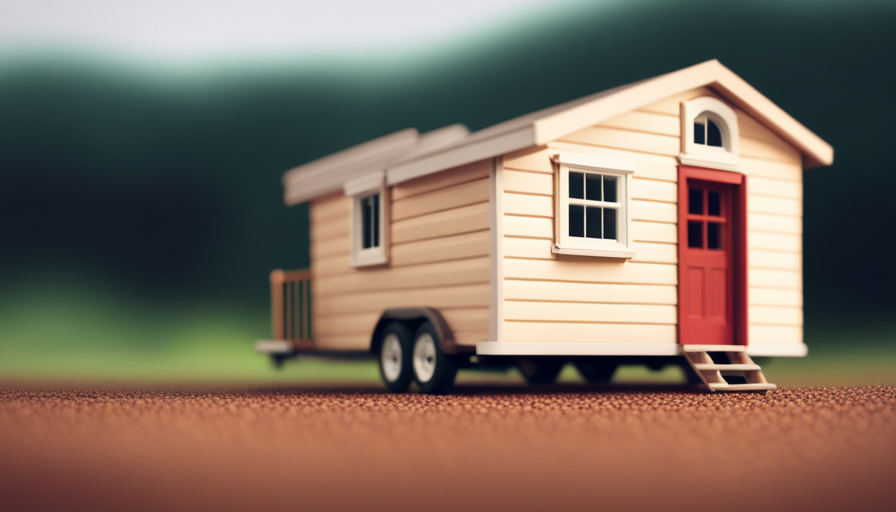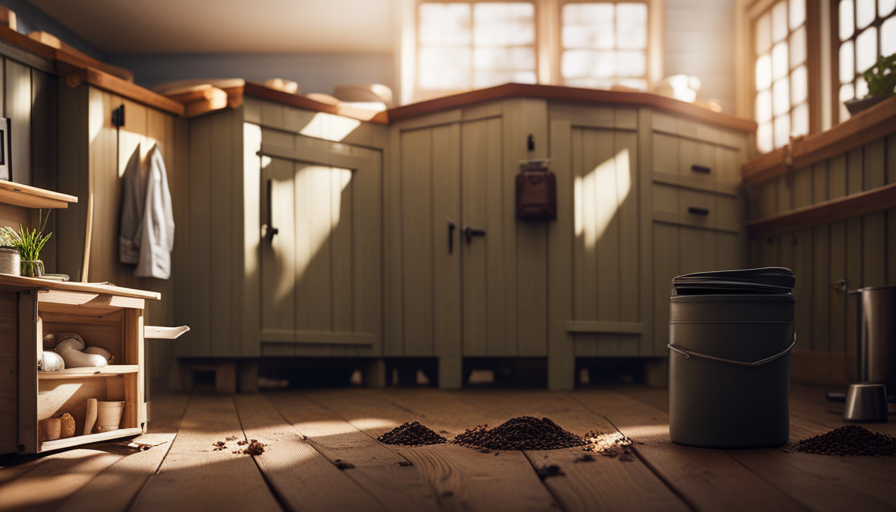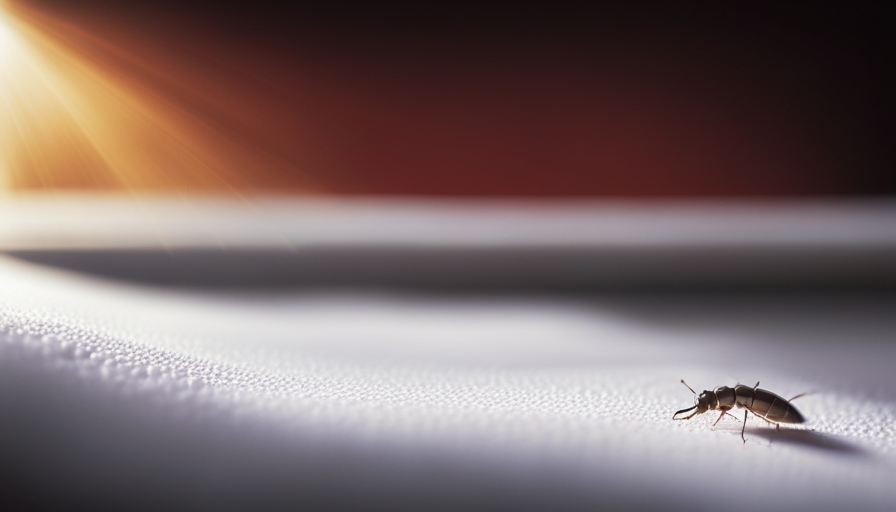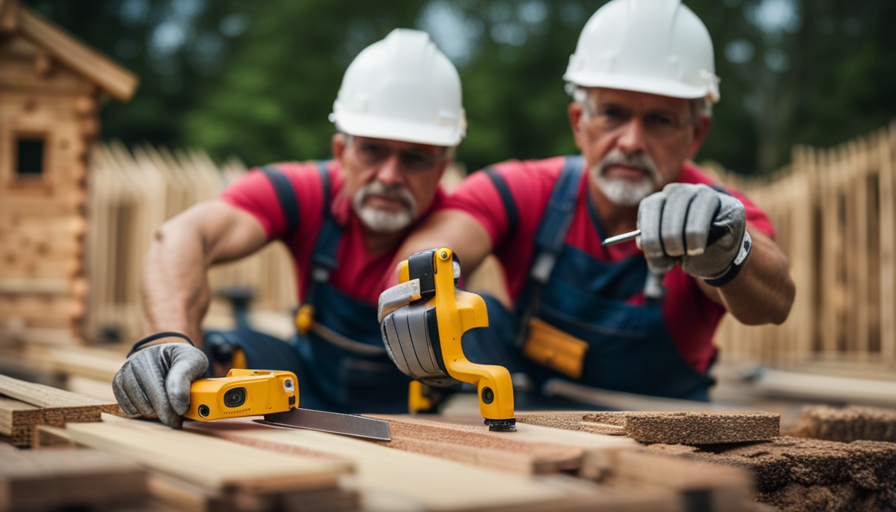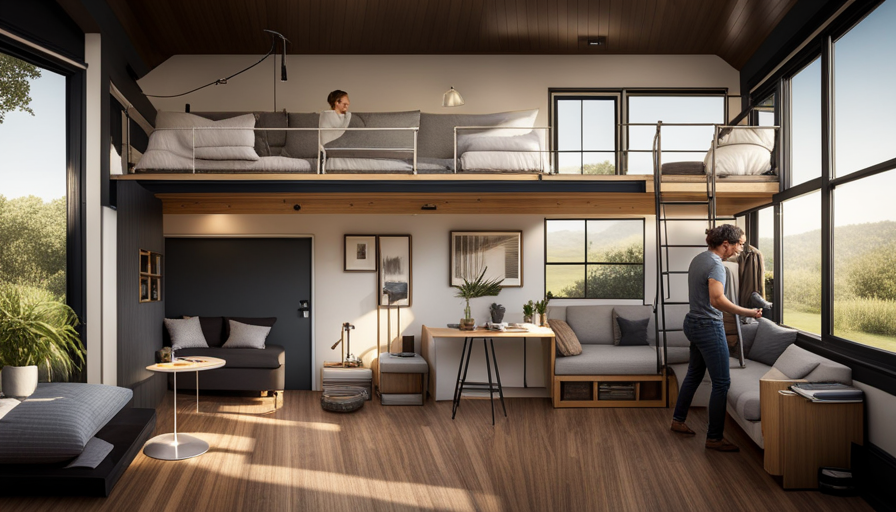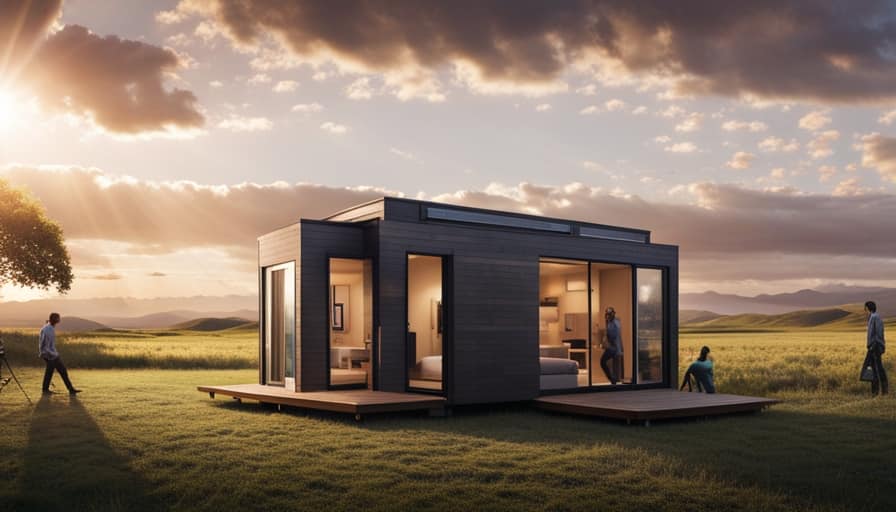Have you ever been curious about the total length of a 20FT tiny house, hitch included?
Picture a compact dwelling, a sanctuary on wheels, that unlocks a world of freedom and flexibility. Just like the wings of a bird, the hitch is the lifeline that connects the tiny house to its towing vehicle, enabling it to soar through the open road.
In this article, I will unravel the mystery surrounding the dimensions of a 20FT tiny house, including the hitch. By delving into the standard length, factors that affect the overall size, and measurement techniques, we will gain a comprehensive understanding of these pint-sized abodes.
Along the way, we will debunk common misconceptions and unearth ingenious design ideas to maximize space. So, join me on this journey as we navigate the world of tiny houses and unlock the secrets of their true length.
Key Takeaways
- The dimensions of a 20FT tiny house can vary depending on design and construction, but typically measure 20’x8’x13.5′.
- The hitch adds 3-4 feet to the overall length of a tiny house, making the total length range from 23-24 feet.
- Proper hitch installation is important for weight distribution and stability during transit, ensuring safe transportation and proper placement.
- Including the hitch in length measurements is crucial for transportation planning, parking allocation, and selecting an appropriate towing vehicle and trailer.
Explanation of Tiny House Dimensions
When you see the dimensions of a tiny house, you won’t believe how much space can be packed into just 20ft, including the hitch.
The dimensions of a 20ft tiny house typically refer to the length of the house without considering the hitch. It is important to note that the dimensions can vary slightly depending on the design and construction of the tiny house.
Generally, a 20ft tiny house measures around 20 feet in length, 8 feet in width, and 13.5 feet in height. These dimensions are carefully planned to optimize the available space and provide a comfortable living environment. The interior of a 20ft tiny house usually includes a living area, kitchen, bathroom, and sleeping loft.
Despite its small size, a well-designed tiny house can offer all the necessary amenities for a comfortable lifestyle. Understanding the role of the hitch is crucial when considering the overall dimensions of the tiny house. The hitch extends beyond the 20ft length, so it’s important to account for this additional space when planning and transporting the tiny house.
Understanding the Role of the Hitch
Imagine hitching your 20ft tiny home to your vehicle, only to realize that the hitch adds an unexpected twist to the length. Understanding the functionality of the hitch is crucial when it comes to towing your tiny house. The hitch serves as the connection point between the trailer and your vehicle, ensuring a safe and secure journey. It not only bears the weight of the tiny house but also provides stability and control during transportation.
Proper hitch installation is of utmost importance to ensure the safety of your tiny house and everyone on the road. The hitch must be compatible with your vehicle’s towing capacity and properly installed to distribute the weight evenly. Failure to install the hitch correctly can lead to accidents, damage to your vehicle, or even detachment of the tiny house during transit.
Now, let’s move on to the next section about the standard length of a 20ft tiny house.
The Standard Length of a 20FT Tiny House
Hitching your 20ft tiny home to your vehicle creates a connection point that ensures a safe and secure journey, while also adding an unexpected twist to the overall length.
When considering the dimensions of a 20ft tiny house, it’s crucial to take into account the impact of the hitch on the overall length. The hitch itself can add an additional 3 to 4 feet to the overall length of the tiny house. This means that the actual length of the tiny house, including the hitch, can range from 23 to 24 feet.
Understanding the significance of tiny house dimensions is essential, especially when it comes to transportation and parking. Many states have regulations regarding the maximum length of a vehicle and trailer combination. Therefore, it’s crucial to be aware of the overall length of your tiny house, including the hitch, to ensure compliance with these regulations.
Moving forward, it’s important to consider other factors that can affect the overall length of a 20ft tiny house. These factors can include the design of the tiny house, such as additional overhangs or extensions, as well as any modifications made to the hitch itself.
By carefully considering these factors, you can ensure that your 20ft tiny house, including the hitch, remains within the appropriate length limits for safe and legal transportation.
Factors That Can Affect the Overall Length
Consider the various elements that can impact the overall length of your 20ft tiny home, such as design features like additional overhangs or extensions, and any modifications you make to the hitch itself, which can potentially add several feet to its size. These factors affecting length are important to consider when planning your tiny house build, as they can significantly impact the available living space.
Some design choices that can affect the length of your tiny home include adding a porch or deck, which can extend beyond the main structure. Another factor is the inclusion of loft spaces, which can increase the height and overall dimensions of the house. Additionally, if you choose to include a bathroom or kitchen, this can also impact the size of the tiny home.
It is crucial to carefully consider these design choices before starting your project, as they can affect the overall length and functionality of your tiny home. By making informed decisions, you can ensure that your tiny house meets your specific needs and preferences.
Next, we will explore measurement techniques for including the hitch, which is an important aspect of determining the overall length of your 20ft tiny house.
Measurement Techniques for Including the Hitch
To accurately determine the overall length of your 20ft small dwelling, it’s essential to employ precise measurement techniques that account for the inclusion of the hitch.
When measuring the length of a tiny house, it’s crucial to consider the hitch as it extends beyond the main structure. The hitch is the part that connects the house to the towing vehicle, and it plays a significant role in determining the total length.
To obtain accurate measurements, start by positioning the tiny house on a level surface. Measure from the front of the house, excluding the hitch, to the farthest point at the back. Then, measure the length of the hitch separately. Add the length of the house and the hitch measurements to get the overall length.
Taking precise measurements is vital when planning for transportation, parking, or designing specific spaces within the tiny house. By including the hitch in the length measurements, you ensure accurate dimensions are accounted for, allowing for better planning and utilization of space.
Benefits of Including the Hitch in Length Measurements
Including the hitch in length measurements can provide valuable information for transportation and parking purposes. It allows for better planning and utilization of available space, resulting in a more efficient use of resources. By including the hitch, the total length of a 20ft tiny house can be accurately determined, taking into account the additional space needed for hitch attachments. This ensures that the tiny house can be safely transported and parked without any unexpected complications.
One of the key benefits of including the hitch in length measurements is that it helps in determining the total space required for parking. Whether it’s in a dedicated tiny house community or a private property, knowing the exact length of the tiny house including the hitch allows for proper placement and allocation of space. This helps in avoiding overcrowding and ensures that each tiny house has enough room for comfortable living.
Additionally, including the hitch in length measurements aids in determining the transportation requirements for moving the tiny house from one location to another. It provides crucial information for selecting the appropriate towing vehicle and trailer, ensuring that the tiny house can be safely and legally transported.
Incorporating the hitch in length measurements is essential for accurate planning and resource management. It allows for efficient utilization of available space, proper parking arrangements, and safe transportation. By considering the hitch, one can make informed decisions regarding the logistics of a 20ft tiny house.
With this understanding, let’s explore common misconceptions about tiny house length.
Common Misconceptions About Tiny House Length
Misunderstandings about the size of tiny houses often lead to surprising revelations when it comes to their overall length. Many people mistakenly believe that the length of a tiny house is solely determined by the interior living space, excluding the hitch. However, the hitch plays a crucial role in the overall dimensions of a tiny house on wheels.
Here are some common misconceptions about tiny house length:
-
Excluding the hitch: Some people assume that the hitch doesn’t count in the measurements. However, the hitch can add an additional 3 to 4 feet to the overall length of a tiny house.
-
Measuring techniques: Another misconception is that tiny house dimensions are measured solely from the interior walls. In reality, the length includes the exterior walls and any protrusions such as bump-outs or lofts.
-
Space optimization: Many people underestimate the importance of optimizing space in a tiny house. Effective design ideas, such as utilizing multi-functional furniture and maximizing vertical space, can help create a spacious and comfortable living environment.
-
Compact living: Some misconceptions suggest that living in a tiny house means sacrificing comfort and style. However, with careful planning and design choices, a 20ft tiny house can provide all the necessary amenities and even incorporate luxurious features.
Misconceptions about tiny house length can lead to unrealistic expectations. Understanding the role of the hitch and adopting space optimization techniques are essential for maximizing space in a 20ft tiny house.
Tips for Maximizing Space in a 20FT Tiny House
Make the most of every inch in your 20-foot micro abode by thinking vertically and embracing the sky as your limit.
In a tiny house, where space is at a premium, it’s crucial to maximize storage and utilize space-saving furniture. One effective way to do this is by incorporating built-in storage solutions throughout your tiny house. Consider utilizing under-bed storage, wall-mounted shelves, and hidden compartments to make the most of every nook and cranny.
Additionally, choose multifunctional furniture pieces that can greatly enhance the functionality of your space. Look for items like convertible sofas, folding tables, and collapsible chairs to optimize your living area. These clever space-saving solutions will allow you to have all the essential furniture without sacrificing precious square footage.
Furthermore, don’t forget to make use of vertical space. Install shelving units that reach the ceiling, and consider using hooks or hanging organizers on walls or the back of doors. This will provide additional storage for items such as clothing, kitchen utensils, and cleaning supplies. By utilizing every available surface, you can create a more organized and clutter-free environment.
In the next section, explore creative design ideas for compact living that will further enhance the functionality and aesthetics of your 20-foot tiny house.
Creative Design Ideas for Compact Living
Get inspired with these creative design ideas that’ll transform your compact living space into a functional and stylish oasis. When living in a small space, it’s essential to maximize every inch. Here are some compact storage solutions and space-saving furniture ideas to help you make the most of your tiny house:
-
Built-in shelves: Utilize vertical space by incorporating built-in shelves throughout your tiny house. These can be used to store books, decorations, and everyday essentials, keeping them off the floor and creating a clutter-free environment.
-
Fold-out furniture: Invest in fold-out furniture pieces like foldable tables and chairs. These can be easily tucked away when not in use, providing you with more floor space to move around.
-
Loft beds: Consider installing a loft bed to maximize vertical space. This’ll free up valuable floor space, allowing you to utilize the area underneath for storage or as a workspace.
-
Hidden storage: Incorporate hidden storage solutions like under-bed storage drawers or storage compartments in furniture pieces. These discreet storage options will help keep your belongings organized and out of sight.
-
Multi-purpose furniture: Opt for furniture pieces that serve multiple functions, like a sofa that can transform into a bed or a coffee table with built-in storage. This’ll minimize the number of furniture pieces you need, saving both space and money.
By implementing these compact storage solutions and space-saving furniture ideas, you can create a well-organized and efficient living space in your tiny house. Transitioning into the conclusion and final thoughts section, it’s important to remember that maximizing space is crucial when living in a small home.
Conclusion and Final Thoughts
In conclusion, it’s essential to maximize space when living in a compact abode, and by implementing these smart design ideas, you can create an efficient and stylish oasis that will make your small space feel like a cozy haven.
When it comes to maximizing space in a tiny house, every square inch counts. Utilizing multi-functional furniture is key, such as a sofa that can transform into a bed or a dining table that doubles as a workspace. Additionally, incorporating built-in storage solutions like hidden cabinets and pull-out drawers can help keep your belongings organized and out of sight.
Another clever way to maximize space is by utilizing vertical space. Installing wall-mounted shelves or hanging storage units can create additional storage space without taking up valuable floor area.
Lastly, using light colors and mirrors can create an illusion of a larger space by reflecting light and making the room feel more open and airy. These design ideas, when combined, can help you make the most of your compact living space and create a comfortable and functional home.
Frequently Asked Questions
What are some common misconceptions about the length of a 20FT tiny house?
Common misconceptions about the length of a 20ft tiny house are often related to underestimating the space available. Many people assume that such a small house will be cramped and uncomfortable. However, the benefits of a 20ft tiny house are quite the opposite. With clever design and utilization of space, these homes can provide all the necessary amenities and even feel spacious.
They are an ideal choice for individuals seeking simplicity, affordability, and a minimalist lifestyle.
Are there any tips for maximizing space in a 20FT tiny house?
When it comes to maximizing space in a 20ft tiny house, there are a few tips to keep in mind.
Firstly, utilizing storage options that make the most of vertical space is essential. This can include installing shelves or cabinets that reach up to the ceiling.
Secondly, investing in space-saving furniture, such as a folding bed or a pull-out dining table, can help to optimize the available space.
By implementing these strategies, you can effectively make the most of the limited space in a 20ft tiny house.
Can you provide some creative design ideas for compact living in a 20FT tiny house?
When it comes to compact living in a 20ft tiny house, there are numerous creative design ideas to maximize space.
One effective approach is to incorporate compact living furniture, such as folding tables, wall-mounted desks, and multipurpose seating with hidden storage compartments.
Additionally, space-saving storage solutions like built-in shelving, under-bed storage, and vertical storage systems can help optimize every inch.
These clever design elements can make a significant difference in creating a functional and organized living space within a limited footprint.
What factors can affect the overall length of a 20FT tiny house?
Factors that can affect the overall length of a 20ft tiny house include the layout and design choices made during construction. Efficient space maximization is crucial in tiny house design, so factors such as the inclusion of multiple levels, loft spaces, or built-in storage solutions can impact the overall length.
Additionally, the choice of materials, appliances, and fixtures can also influence the overall length, as more compact options may be utilized to optimize space.
Are there any measurement techniques specifically for including the hitch in the length of a 20FT tiny house?
Measurement techniques for accurately determining the length of a 20ft tiny house, including the hitch, are available. These techniques ensure precise measurements and account for the hitch’s inclusion in the overall length.
By utilizing tools such as a tape measure or laser distance meter, one can measure from the very front of the hitch to the rear of the tiny house. This method guarantees accurate measurements and aids in determining the exact length of the tiny house, including the hitch.
Conclusion
In conclusion, after thorough investigation and analysis, it’s clear that the length of a 20ft tiny house, including the hitch, is a crucial factor to consider when planning for compact living.
By understanding the dimensions and role of the hitch, individuals can make informed decisions about their tiny house design and maximize space effectively.
It’s important to debunk common misconceptions and utilize creative design ideas to optimize the living experience.
With precise measurement techniques and careful consideration, the truth about tiny house length can be uncovered, allowing for a truly efficient and comfortable living space.
Hi, I’m Emma. I’m the Editor in Chief of Tiny House 43, a blog all about tiny houses. While tree houses are often associated with childhood, they can be the perfect adult retreat. They offer a cozy space to relax and unwind, surrounded by nature. And since they’re typically built on stilts or raised platforms, they offer stunning views that traditional homes simply can’t match. If you’re looking for a unique and romantic getaway, a tree house tiny house might just be the perfect option.
